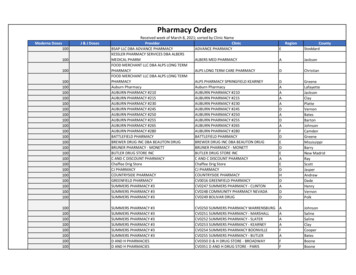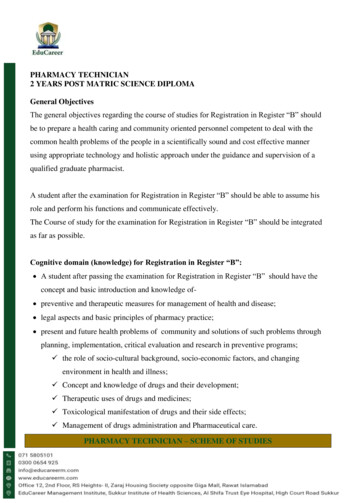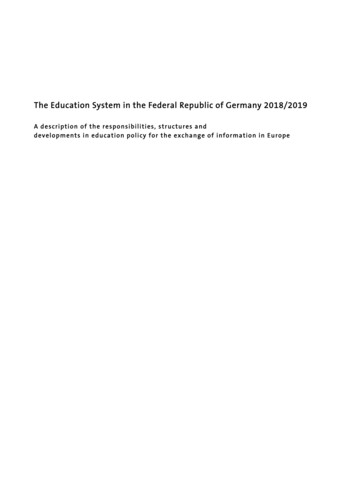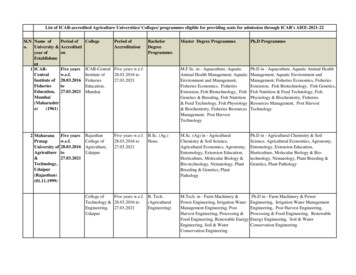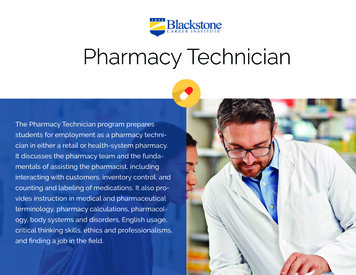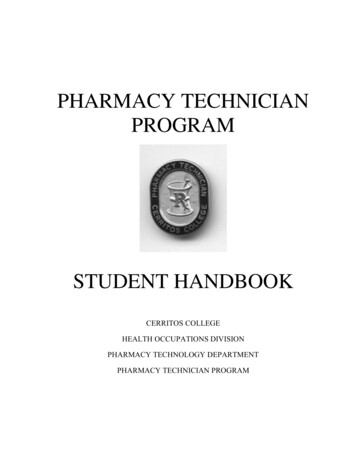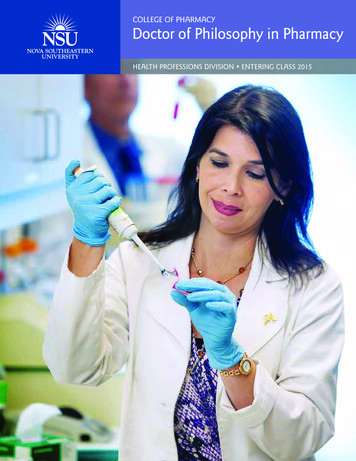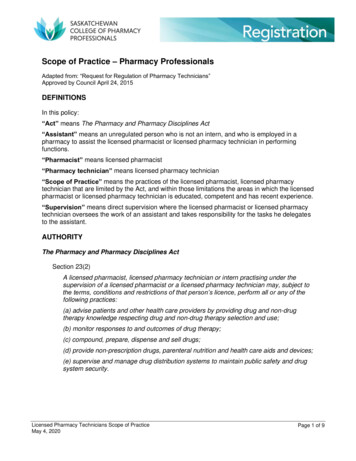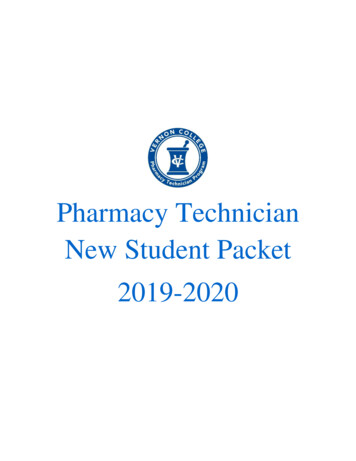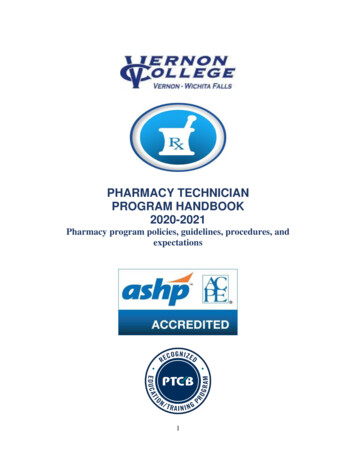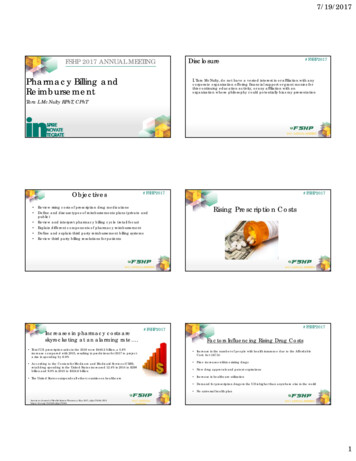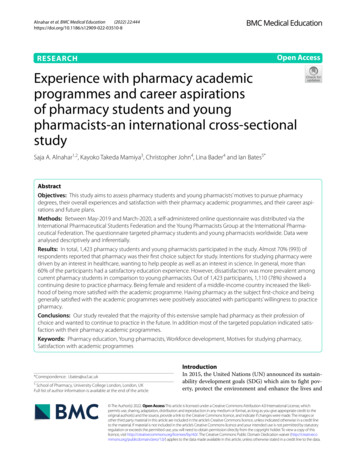
Transcription
(2022) 22:444Alnahar et al. BMC Medical 8Open AccessRESEARCHExperience with pharmacy academicprogrammes and career aspirationsof pharmacy students and youngpharmacists‑an international cross‑sectionalstudySaja A. Alnahar1,2, Kayoko Takeda Mamiya3, Christopher John4, Lina Bader4 and Ian Bates5*AbstractObjectives: This study aims to assess pharmacy students and young pharmacists’ motives to pursue pharmacydegrees, their overall experiences and satisfaction with their pharmacy academic programmes, and their career aspirations and future plans.Methods: Between May-2019 and March-2020, a self-administered online questionnaire was distributed via theInternational Pharmaceutical Students Federation and the Young Pharmacists Group at the International Pharmaceutical Federation. The questionnaire targeted pharmacy students and young pharmacists worldwide. Data wereanalysed descriptively and inferentially.Results: In total, 1,423 pharmacy students and young pharmacists participated in the study. Almost 70% (993) ofrespondents reported that pharmacy was their first choice subject for study. Intentions for studying pharmacy weredriven by an interest in healthcare, wanting to help people as well as an interest in science. In general, more than60% of the participants had a satisfactory education experience. However, dissatisfaction was more prevalent amongcurrent pharmacy students in comparison to young pharmacists. Out of 1,423 participants, 1,110 (78%) showed acontinuing desire to practice pharmacy. Being female and resident of a middle-income country increased the likelihood of being more satisfied with the academic programme. Having pharmacy as the subject first-choice and beinggenerally satisfied with the academic programmes were positively associated with participants’ willingness to practicepharmacy.Conclusions: Our study revealed that the majority of this extensive sample had pharmacy as their profession ofchoice and wanted to continue to practice in the future. In addition most of the targeted population indicated satisfaction with their pharmacy academic programmes.Keywords: Pharmacy education, Young pharmacists, Workforce development, Motives for studying pharmacy,Satisfaction with academic programmes*Correspondence: i.bates@ucl.ac.uk5School of Pharmacy, University College London, London, UKFull list of author information is available at the end of the articleIntroductionIn 2015, the United Nations (UN) announced its sustainability development goals (SDG) which aim to fight poverty, protect the environment and enhance the lives and The Author(s) 2022. Open Access This article is licensed under a Creative Commons Attribution 4.0 International License, whichpermits use, sharing, adaptation, distribution and reproduction in any medium or format, as long as you give appropriate credit to theoriginal author(s) and the source, provide a link to the Creative Commons licence, and indicate if changes were made. The images orother third party material in this article are included in the article’s Creative Commons licence, unless indicated otherwise in a credit lineto the material. If material is not included in the article’s Creative Commons licence and your intended use is not permitted by statutoryregulation or exceeds the permitted use, you will need to obtain permission directly from the copyright holder. To view a copy of thislicence, visit http:// creat iveco mmons. org/ licen ses/ by/4. 0/. The Creative Commons Public Domain Dedication waiver (http:// creat iveco mmons. org/ publi cdoma in/ zero/1. 0/) applies to the data made available in this article, unless otherwise stated in a credit line to the data.
Alnahar et al. BMC Medical Education(2022) 22:444prospects of human beings [1]. The third goal, “ensurehealthy lives and promote well-being for all at all ages”,aims to achieve universal health coverage (UHC) andminimise the variations between healthcare systemsworldwide [1]. Integral to achieving UHC is the continuous and sustainable supply of qualified and trainedhealthcare professionals [1]. Additionally, in its 2030strategy, the World Health Organisation (WHO) considered qualifying, training and enforcing a competenthealthcare workforce as key for meeting the growingdemands of the general population for healthcare services [2]. However, despite all the efforts to achieve UHC,recent figures show that by 2030, healthcare systems,mainly in low and middle-income countries, will sufferfrom a shortfall of eighteen million healthcare workers[3]. The shortage is expected to include different professions and specialisations such as medicine, nursing, alliedhealthcare, and pharmacy [2, 3].Pharmacists are the experts in medicines: in understanding medicines’ pharmacological characteristics,dosing regimen, possible interactions and adverse drugreactions. In addition, pharmacists, especially community pharmacists, are frequently reported to be the mostaccessible healthcare professionals, whether in developing or developed countries [4, 5]. Through their knowledge, expertise, and services, Pharmacists play a centralrole in supporting national healthcare systems, providingprimary healthcare, and achieving universal health coverage (UHC) [6]. Therefore, a shortage in the pharmacyworkforce could limit patient access to medicines andhealth services and care and also hinder the achievementof UHC.The pharmaceutical workforce represents an interesting case of healthcare professions. Over the years, thepharmacy profession has been experiencing variationsin workforce capacity between countries worldwide [7].While the forecasted shortage is expected to affect different healthcare professions, especially in low and middle-income countries, shortages in the pharmaceuticalworkforce have been reported by high-income countriessuch as the United States of America, the United Kingdom and Australia [8–11]. On the other hand, middleand low-income countries are witnessing an increasein the total number of qualified pharmacists and animprovement in the density of pharmacists per 10,000population [7, 12].Shortage in the pharmaceutical workforce in highincome countries could encourage and increase theimmigration of pharmacists from low and middle-incomecountries. Accordingly, the healthcare sector and pharmacy profession in high-income countries would be reliant on foreign-trained and qualified pharmacists in thenear future. Therefore, there is a need to ensure a matchPage 2 of 10between immigrant pharmacists’ competencies (supply)and the healthcare system needs (demand). For that reason, there is a need to understand the main competenciespharmacy graduates need to develop and acquire to meetthe demand of healthcare systems worldwide.In addition to immigration, healthcare and highereducation policymakers should develop interventionsthat encourage students to study and practice pharmacy. Therefore, one way of addressing the shortagein the pharmacy workforce is to understand what factors motivate students to choose a pharmacy and theiroverall experiences and satisfaction with their academicprogrammes.A large body of literature looked at pharmacy students’motives for studying pharmacy, their overall experienceswith their academic programmes, and their future careerplans. However, available literature highlights motivesand drives to study pharmacy at a national and localhealthcare system level. Therefore, it might be used inhelping national systems in creating policies and schemesto encourage students’ enrolment into pharmacy degreeprogrammes. Furthermore, as UNSDG#3 aims to achieveuniversal health coverage and minimises the variationsbetween healthcare systems worldwide, students shouldbe encouraged to enrol in pharmacy degree programmes.Study aim and objectivesThis study aims to provide a comprehensive assessmentof pharmacy students and young pharmacists’ motivesand drives to pursue a pharmacy degree, their overallexperiences and satisfaction with their pharmacy academic programmes, and their career aspiration andfuture plans.MethodsStudy settings, design and subjectsThis study is a global cross-sectional study that targetedyoung pharmacists and pharmacy students worldwide.As the target population’s exact size is unknown, a minimal sample of 377 participants from each category wasneeded. The sample size was calculated based on a 95%confidence interval, a standard deviation of 5%, 0.05 levelof significance and an unlimited population size.Data collection tool and study instrumentMigration patterns, motives, influencers and barrierswere explored using a self-administered questionnaireinstrument. The research team developed the instrumentbased on a thorough literature review and the study’saims and objectives. Literature review was focused ontheories, models and research addressing motives forstudying and specialisations, experiences with academics programmes and factors correlated with academic
Alnahar et al. BMC Medical Education(2022) 22:444satisfaction. The first version of the instrument wasreviewed and assessed by subject-matter experts. Following experts’ assessment, the instrument was amended,and two versions, one for students and one for youngpharmacists, were created.Each questionnaire instrument consisted of elevenquestions grouped into four sections as per the following:section one: participant’s demographics and characteristics such as occupation, nationality and gender. Sectiontwo: motives and drives for studying pharmacy. SectionThree: participants’ experience with the academic programme. Section Four: participants career aspirations.As this study is an international study, the final versionwas translated into French, Spanish, Portuguese, Arabic,Chinese, Indonesian and Japanese. Translated versionswere checked and validated by native speakers. The finalsurvey instruments were self-administered using theQualtrics platform.In the period between May 2019 and March 2020, thetargeted participants were sent the survey link via email,which was distributed through the International Pharmaceutical Students Federation (IPSF) and the YoungPharmacists Group at the International PharmaceuticalFederation (YPG-FIP).Statistical analysisFollowing the data collection phase, data were extractedand logged in an Excel workbook (Microsoft Office MS,2013). Data cleaning, coding and groping were carriedout.Motives and drives for studying pharmacy weregrouped into three main categories: science focused,career consideration and personal aspiration. Moreover, competencies were grouped according to the FIPGlobal Competency Framework into four main categories: pharmaceutical care, pharmaceutical public health,professional/personal organisation and managementcompetencies. As a five-point Likert-scale was used toassess participants’ satisfaction with their academic programme, the scale was convert into three-points to easeand facilitate the analysis. Accordingly, the first two categories (strongly agree and agree) were grouped into one(agree), the last two categories (strongly disagree and disagree) were grouped into one (disagree), the intermediatescale (neither) was left as it is.Descriptive analysis, frequencies and percentages, wasused to report participants’ demographics and characteristics, motives for studying pharmacy, and satisfactionwith the academic programme. Z-test was used to standardise scores and compare between students and youngpharmacists. Chi-square test of independence was usedto investigate differences between different country categories. Inferential analysis and ordered logistic regressionPage 3 of 10were used to determine factors associated with the overall satisfaction with the academic programme and participants’ willingness to practice pharmacy. Data analysiswas carried out using STATA data analysis and statistical software (StataCorp, 2016).Ethical considerationThe Research Ethics Committee at University CollegeLondon reviewed and approved this study (Ethic Identifier Number: 14103/001).ResultsParticipants demographics and characteristicsIn total, 1,423 participants; 751 (52.8%) young pharmacists and 672 (47.2%) pharmacy students; participatedin this study. As the questionnaire was distributed electronically via the IPSF and YPG-FIP, it was not possibleto know the exact number of approached potential participants. Therefore, it was not possible to calculate theresponse rate.Out of the 1,423 participants, 513 (63%) were female.The research participants came from 99 countries; 696(48.1%) from High income countries, 213 (15.0%) fromUpper-middle income countries, 459 (32.3%) fromLower-middle income countries, and 55 (3.9%) fromLow income countries. Table 1 summarises participants’demographics and characteristics.Participants’ motives for studying pharmacyOut of 1,423 participants, 993 (69.8%) stated that pharmacy was their first choice for studying. As a profession, pharmacy was preferred by young pharmacistsmore than pharmacy students (p-value 0.006), Table 2.Significant difference was also observed between countries, as participants from high income countries weremore willing to select pharmacy as a profession. Desirefor studying pharmacy was driven by a number of factors; mainly: interest in healthcare, wanting to help people and an interest in science. Differences were observedbetween young pharmacists and pharma students inthe number of motives, mainly the career considerationand aspiration related factors. Interest in healthcare andpossible job opportunities were the main drives amonglow-income countries participants. On the other hand,influence of social circle, whether family members or others, did not influence the preference of low-income countries participants, Fig. 1 shows the differences betweencountries in motives for studying pharmacy.Participants’ experiences with academic programmesUpon investigating their overall experiences withtheir academic programmes, more than 60% of thestudy’s participants had a satisfactory experience.
Alnahar et al. BMC Medical Education(2022) 22:444Page 4 of 10Table 1 Participants’ characteristics and demographicsDemographicPharmacy StudentsN (%)Young PharmacistsN (%)Overall ParticipantsN (%)Number672 (47.2%)751 (52.8%)1,423 (100%)GenderMale220 (32.7%)293 (39.0%)513 (36.1%)Female447 (66.5%)449 (59.8%)896 (63.0%)Prefer not to say5 (0.7%)9 (1.2%)14 (1.0%)Marital StatusSingle545 (81.1%)434 (57.8%)979 (68.8%)In a stable relationship120 (17.9%)140 (18.6%)260 (18.3%)Married7 (1.0%)177 (23.6%)184 (12.9%)CountryHigh income291 (43.3%)405 (53.9%)696 (48.9%)Upper-middle income126 (18.8%)87 (11.6%)213 (15%)Lower-middle income219 (32.6%)240 (32%)459 (32.3%)Low income36 (5.4%)19 (2.5%)55 (3.9%)Dissatisfaction was more prevalent among pharmacystudents (p-value 0.014). Comparison between countries classification showed that there is a significant difference between countries. While the highest satisfactionwas observed among participants from lower-middleincome countries (66.9%), the highest dissatisfaction wasreported by low-income countries participants (34.5%).A high proportion of participants wanted to have moretraining and education related to pharmaceutical carecompetencies and skills. On the other hand, lowerpercentage of participants wanted to acquire moreknowledge related to organisation and managementcompetencies. Table 2 summarises experiences, relatedfindings and results.Participants career aspirationOut of 1,423 participants, 1,110 (78%) showed a desire topractice pharmacy. Young registered pharmacists weresignificantly higher in their desire to practice pharmacythan pharmacy students (p-value 0.00001). Morethan 40% of participants, who were intending to practice pharmacy, wanted to work at community pharmacysettings, while only 8.3% wanted to have a career in academia and research. Several reasons were reported fornot wanting to practice pharmacy. Pursuing further studies was the main reason for 42% of participants, who didnot want to practice pharmacy, followed by better salaryopportunities at other professional sectors, Table 2.Significant differences were also observed betweencountries; as the highest percentage (12.7%) of participants, who did not want to practice pharmacy, wereresident of low income countries. Differences were alsoobserved in the selected sector of practice; 62% of highincome residents wanted to work at a community pharmacy settings, Fig. 2.Predictors of satisfaction with academic pharmacyprogrammeSeveral factors were considered to predict participants’satisfaction with the academic programme. These factors were gender identity, World Bank classification ofcountry of residency and having pharmacy as the firstchoice for professional qualification. Inferential analysisrevealed that satisfaction with the academic programmewas significantly associated with two main factors: gender and country of residency. Results showed that femaleparticipants were more satisfied with their academic programme than male participants. Interestingly, being aresident of a middle income country increased the likelihood of being satisfied with the academic pharmacyprogramme in comparison to upper income countries.A marginal association (p-value 0.053) was foundbetween having pharmacy as the first choice and beingoverall satisfied with the academic programme. Table 3shows regression model output.Predictors of career aspirations and future plansLastly, factors that could predict career aspirations andfuture plans were investigated. Associations betweenwanting to practice pharmacy and gender identity, overall satisfaction with academic programme, having pharmacy as the first choice for professional qualification andWorld Bank classification of the country of residencywere investigated. Ordered logistic regression showedthat there were significant associations between all investigated factors and participants’ willingness to practice
Alnahar et al. BMC Medical Education(2022) 22:444Page 5 of 10Table 2 Motives and overall experiences with studying pharmacyInvestigated AttributesPharmacy StudentsN (%)Young PharmacistsN (%)Overall ParticipantsN (%)Pharmacya445 (66.2%)548 (73%)993 (69.8%)Medicinea136 (20.2%)86 (11.5%)222 (15.6%)Chemistry15 (2.2%)14 (1.9%)29 (2.0%)FIRST CHOICE FOR ACADEMIC SPECIALISATIONDentistry14 (2.1%)12 (1.6%)26 (1.8%)Others62 (9.2%)91 (12.1%)153 (10.8%)MOTIVES FOR STUDYING PHARMACY bIntrinsic FactorsInterest in Healthcare485 (72.2%)516 (68.7%)1,001 (70.3%)To Help People348 (51.8%)315 (41.9%)663 (46.6%)Interest in Science326 (48.5%)313 (41.7%)639 (44.9%)To Migrate Abroad148 (22.0%)109 (14.5%)257 (18.1%)Career and Professional ConsiderationJob Opportunities254 (37.8%)278 (37%)532 (37.4%)Attractive Salary235 (35%)193 (25.7%)428 (30.1%)Job Security153 (22.8%)157 (20.9%)310 (21.8%)Job Variety160 (23.8%)130 (17.3%)290 (20.4%)Family Business37 (5.5%)37 (4.9%)74 (5.2%)Personal AspirationFamily Influence187 (27.8%)236 (31.4%)423 (29.7%)Professional Status152 (22.6%)168 (22.4%)320 (22.5%)Influence of Others44 (6.5%)33 (4.4%)77 (5.4%)Unsure15 (2.2%)23 (3.1%)38 (2.7%)Other Motivesa19 (2.8%)10 (1.3%)29 (2.0%)OVERALL SATISFACTION WITH ACADEMIC PHARMACY PROGRAMMEcVery Satisfieda105 (15.6%)168 (22.4%)273 (19.2%)Satisfied301 (44.8%)314 (41.8%)615 (43.2%)Neither113 (16.8%)138 (18.4%)251 (17.6%)Dissatisfied107 (15.9%)104 (13.8%)211 (14.8%)Very Dissatisfieda43 (6.4%)25 (3.3%)68 (4.8%)DESIRED COMPETENCIES IN INITIAL PHARMACY EDUCATIONbdPharmaceutical Care CompetenciesPatient Consultation & Diagnosis351 (52.2%)365 (48.6%)716 (50.3%)Monitor Medicines Therapy299 (44.5%)322 (42.9%)621 (43.6%)Medicines Use Optimisation275 (40.9%)318 (42.3%)593 (41.7%)Assessment of Medicines256 (38.1%)264 (35.2%)520 (36.5%)Compounding Medicines222 (33.0%)176 (23.4%)398 (28.0%)Dispensing163 (24.3%)147 (19.6%)310 (21.8%)Pharmaceutical Public Health CompetenciesMedicine Information & Advice311 (46.3%)321 (42.7%)632 (44.4%)Health Promotion243 (36.2%)273 (36.4%)516 (36.3%)Professional/Personal CompetenciesCommunication Skills286 (42.6%)271 (36.1%)557 (39.1%)Quality Assurance & Research in the Work Place280 (41.7%)256 (34.1%)536 (37.7%)Continuing Professional Development222 (33.0%)225 (30.0%)447 (31.4%)Legal & Regulatory Practice206 (30.7%)225 (30.0%)431 (30.3%)Self-Management228 (33.9%)195 (26.0%)423 (29.7%)Professional & Ethical Practice217 (32.3%)206 (27.4%)423 (29.7%)
Alnahar et al. BMC Medical Education(2022) 22:444Page 6 of 10Table 2 (continued)Investigated AttributesPharmacy StudentsN (%)Young PharmacistsN (%)Overall ParticipantsN (%)Organisation and Management CompetenciesImprovement of Pharmacy Service269 (40.0%)281 (37.4%)550 (38.7%)Supply Chain & Management165 (24.6%)198 (26.4%)363 (25.5%)Human Resource Management188 (28.0%)155 (20.6%343 (24.1%)Work Place Management145 (21.6%)167 (22.2%)312 (21.9%)Budget & Reimbursement151 (22.5%)136 (18.1%)287 (20.2%)Procurement108 (16.1%)109 (14.5%)217 (15.2%)Other Competencies23 (3.4%)40 (5.3%)63 (4.4%)Nothing21 (3.1%)35 (4.7%)56 (3.9%)Yesa475 (70.7%)635 (84.6%)1110 (78.0%)Noa24 (3.6%)116 (15.4%)140 (9.8%)Not Decideda173 (25.7%)0 (0.0%)173 (12.2%)Community Pharmacya99 (20.8%)362 (57.0%)461 (41.5%)Hospital Pharmacya158 (33.3%)134 (21.1%)292 (26.3%)Industrial/Marketinga108 (22.7%)53 (8.3%)161 (14.5%)Academia/Researcha61 (12.8%)31 (4.9%)92 (8.3%)Others49 (10.3%)55 (8.7%)104 (9.4%)Change in Profession19 (9.6%)8 (6.9%)27 (8.6%)Further Studiesa102 (51.8%)32 (27.6%)134 (42.8%)Not Interesting25 (12.7%)10 (8.6%)35 (11.2%)Better Salary Opportunities30 (15.2%)19 (16.4%)49 (15.7%)Other Reasonsa21 (10.7%)47 (40.5%)68 (21.7%)CAREER ASPIRATIONWanting to Practice PharmacySelected Sector of PracticeReasons for Not Wanting to Practice PharmacyaThere is a statistically significant difference between the two groups (p-value 0.05)bParticipants were allowed to choose more than one answercSome participants did not provide an answerdCompetencies domains are based on the FIP Global Competency Framework (GbCF) version1pharmacy in the future. Results showed that having pharmacy as the first choice for professional qualification andbeing generally satisfied with the academic programmeswere positively associated with participants’ willingnessto practice pharmacy. Interestingly, being a female and aresident of an upper-middle income country was negatively associated with the career aspiration to practicepharmacy. Table 4 shows output of the ordered logisticregression.DiscussionThis is the first international study to assess the motives,experiences and career aspirations of pharmacy studentsand young pharmacists worldwide. The research teamwas able to get input and data from 1,423 participantsusing a self-reporting questionnaire instrument. Theinstrument collected data related to participants’ demographics and characteristics, leading drives and motivesfor choosing pharmacy as a profession, overall satisfaction with their academic programmes, plans, and setof competencies and skills they wanted to learn and betrained more about during their academic studies.Similar to what was reported in the literature, pharmacy was not always the first choice for studying forpharmacy students [13–16]. However, unlike previousstudies, in this study, the majority, almost 70%, reportedthat pharmacy was their preferred field of study. The highpercentage could be explained by the nature of researchparticipants, as more than 50% of the participants wereyoung pharmacists who were already practising pharmacy and might have a positive attitude toward their profession and career of choice.The choice of career or profession is influenced bya number of social, environmental and backgroundrelated factors [17]. These factors can be extrinsic,intrinsic or both with a different locus of causality and
Alnahar et al. BMC Medical Education(2022) 22:444Fig. 1 Motives and drives for studying pharmacy by country world bank classificationFig. 2 Future career aspiration by country world bank classificationPage 7 of 10
Alnahar et al. BMC Medical Education(2022) 22:444Page 8 of 10Table 3 Ordered logistic regression outputs of satisfactionpredictorsSatisfaction with Academic ProgrammeCO (SE)(95% CI)Female*0.25 (0.11)0.03–0.46Pharmacy being first choice0.24 (0.12)-0.00–0.47Low income country-0.31 (0.28)-0.86–0.23Lower-middle income country*0.33 (0.13)0.08–0.58Upper-middle income country*0.34 (0.17)0.01–0.66*P value 0.05CI Confidence Interval, CO coefficient, N number, p probability value, SE StandardErrorTable 4 Ordered logistic regression outputs of career aspirationIntention to continue to Practice Pharmacy CO (SE)in the Future(95% CI)Female*-0.37 (0.14)-0.64–0.09Pharmacy being first choice*0.38 (0.14)0.11–0.66Low income country0.03 (0.37)-0.70–0.75Lower-middle income country-0.11 (0.15)-0.41–0.19Upper-middle income country*-0.45 (0.18)-0.80–0.09Being satisfied with academic programme*0.47 (0.16)0.16–0.77Being unsatisfied with academic programme0.31 (0.20)-0.09–0.70*P value 0.05CI Confidence Interval, CO coefficient, N Number, p Probability value, SEStandard Errorcontrol [18]. In this study, intrinsic motives “inherentsatisfaction” were the main drives for pursuing a pharmacy degree. Interest in the healthcare and medicalfield was the primary motive for more than 70% of theresearch participants. Interest in healthcare is a commonly reported motive for pharmacy students in anumber of countries with different World Bank classifications such as Qatar, Pakistan, Malaysia, United ArabEmirates and the Kingdom of Saudi Arabia [14, 19–22].The comparison between countries showed thatdrives and motives related to interest in healthcare,better job opportunities, and migrating abroad werehigher among participants from low and lower-middleincome countries. Interest in healthcare and the medical profession could be driven by the challenging statusof national healthcare systems in low-income countries[23]. Choosing the pharmacy profession to pave theway for migration could be driven by better job opportunities, higher salaries, which was one of the maindrives of participants from high-income countries, andbetter lifestyles in high-income countries. This is also inalignment with the general trend in workforce migration from low to high-income countries [24].It is important to assess students and young pharmacists overall experiences and satisfaction with theiracademic programmes, as it could be used as an indicator to predict their ability to learn and develop theirskills and competencies [25]. Results showed that circa60% of the research participants had satisfactory experiences with their academic programmes. These resultsare similar to the results and findings of two previousstudies in Jordan and Sweden [26, 27]. This could beviewed as a disappointing low outcome for a regulatedhealthcare profession. However, overall satisfactionwas significantly associated with some demographicfactors; gender and the country of residency WorldBank income classification. The fact that females weremore satisfied with their academic programmes couldbe explained by the notion that pharmacy is perceivedas female-friendly profession, and females, in general,are more attracted to study and practice pharmacy[28]. The association between the overall satisfactionand country of residency World Bank classificationneeds further and deeper investigation that comparesdifferent countries in terms of methods of studentsrecruitment, offered educational curricula and adaptedteaching and mentoring approaches.Results showed that almost 50% of the study participants were interested in learning more about pharmacyand trained on competencies related to pharmaceutical care and pharmaceutical public health. The desireto receive more training related to these competencies could be explained by the fact that the majority ofthe study participants wanted to practice pharmacy inpatient-facing sectors such as community pharmacy orhospital pharmacy. Regarding the future career aspirations, the study results aligned with previous studiescarried out in countries with different gross nationalincome per capita, such as the United Kingdom, Malaysia and Jordan [26, 29, 30]. Additionally, having similarresults among different classes of countries regardingcareer aspiration might indicate a global trend andinterest toward patient-facing careers. This couldstrengthen and emphasise pharmacists’ role as keyplayers in providing healthcare, mainly primary healthcare [6].The desire to practice pharmacy or work in a pharmacy-related sector was significantly associated withbeing a female and having pharmacy as the first choicefor studying and specialisation. Again, being known asa female-friendly profession might explain why femaleparticipants were more willing to practice pharmacy.Moreover, being initially motivated to study pharmacycould encourage the pharmacy students to practicepharmacy and develop their pharmaceutical skills andknowledge.
Alnahar et al. BMC Medical Education(2022) 22:444ConclusionIn order to properly plan for the development andevolvement of the pharmacy profession, we need tounderstand pharmacy students’ motives and drives tostudy pharmacy. It is also helpful to make sure that we,in the healthcare sector, are recruiting the right peoplewith the right motives and drives. Furthermore, knowing and understanding pharmacy students and youngpharmacists’ future plans and career aspirations mightbe helpful in reviewing, updating and designing educational and training curricula. Moreover, it is of value foreducational and healthcare policymakers to ensure thatthere is a match between the healthcare sector’s needsand demands and the orientation of medical field students, including pharmacy students.Our study revealed that the majority of the pharmacy students and young pharmacists had pharmacy astheir profession of choice and wanted to practice it inthe future. In addition, most of the targeted populationwere satisfied with thei
rations and future plans. Methods: Between May-2019 and March-2020, a self-administered online questionnaire was distributed via the International Pharmaceutical Students Federation and the Young Pharmacists Group at the International Pharma-ceutical Federation. The questionnaire targeted pharmacy students and young pharmacists worldwide. Data were
